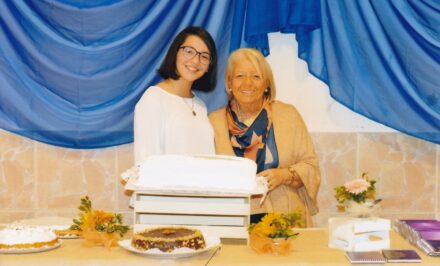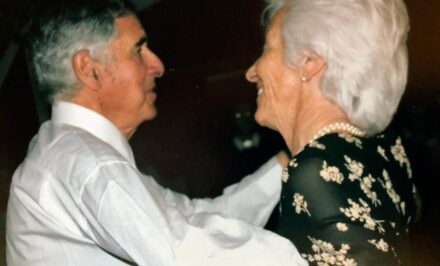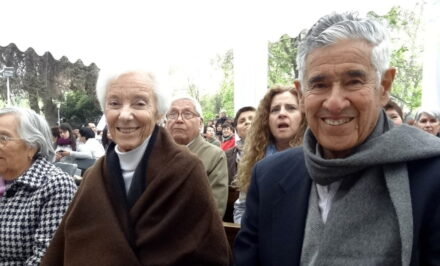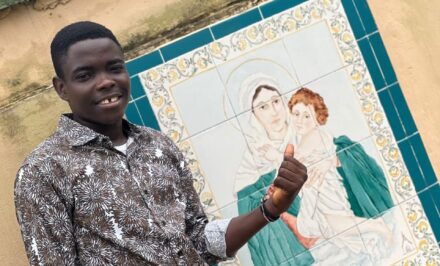 CHILE, mda. Who are the people who will carry Schoenstatt into its second century? They are men and women, young and old, Europeans and Africans, priests and lay people, those who have always belonged to Schoenstatt and those who have recently discovered it. They are missionaries, prophets, pastors, fathers, visionaries, builders, guardians, and conquerors. They are people with unique stories, with their wounds and moments of glory, with covenant stories that are worth relating. People like Rolando Cori, who was interviewed by schoenstatt.org. He was baptized in Bellavista. He composed musical works for Schoenstatt. He participated in the 65th Anniversary of the 31st of May in Bellavista, and he was surprised that there was no news about this on schoenstatt.org. So what happens happened: he was interviewed.
CHILE, mda. Who are the people who will carry Schoenstatt into its second century? They are men and women, young and old, Europeans and Africans, priests and lay people, those who have always belonged to Schoenstatt and those who have recently discovered it. They are missionaries, prophets, pastors, fathers, visionaries, builders, guardians, and conquerors. They are people with unique stories, with their wounds and moments of glory, with covenant stories that are worth relating. People like Rolando Cori, who was interviewed by schoenstatt.org. He was baptized in Bellavista. He composed musical works for Schoenstatt. He participated in the 65th Anniversary of the 31st of May in Bellavista, and he was surprised that there was no news about this on schoenstatt.org. So what happens happened: he was interviewed.
![]()
Who is Rolando Cori?

I was born in Santiago, Chile in 1954. I received an expansive humanistic and scientific education because my parents were biochemists and scholars at the University of Chile, the country’s main university. Since they did not practice any religion, my brother and I were not baptized. At the age of fifteen, I began to study classical guitar, and through music and certain texts, I came to the idea of transcendence. Some of my high school companions and friends invited me to the Schoenstatt Movement in Bellavista, and on Pentecost of 1973, I was baptized there. After joining the Movement, some friends and I composed the music to “Cantata of the 31st of May” written by J.E. Coeymans which made its debut in 1974 at the 25th Anniversary of the mission. I participated in the University Youth and then after spending two years in the community of the Schoenstatt Fathers, I returned to music, and I graduated in composition at the University of Chile. Later, with DADD and KAAD scholarships, I completed my post-graduate studies in composition at the Superior School of Music in Freiburg, Germany. I have been a professor in the Department of Music at the University of Chile since 1973, where I teach composition, harmony and musical counterpoint. I have been the coordinator for the composition track at undergraduate and postgraduate level, the president of the National Association of Composers and a university Senator. My musical works have debuted and been recorded in several countries. Presently, along with other academic musicians, I am part of a musical improvisation group, “Tierra de Larry” (Land of Larry) and I am working on a doctorate in the philosophy of aesthetics. I have been married to Maria Elena Gronemeyer since 1985; she worked in Schoenstatt during Father Kentenich’s centenary as a journalist in Geschaftstelle ’85. We have two sons, Pedro, an engineer and José, a sculptor. I have been part of the first course of the Men’s Federation in Chile for several years, whose ideal is “Father’s Apostles, Covenant Bread for the New City”.
You are a music professor; you have made several musical contributions to Schoenstatt. What is your musical relationship with Schoenstatt? How do you express Schoenstatt’s mystery and mission through music?

When I returned to Chile after being with the Schoenstatt Fathers, I studied composition because I felt that my mission was to evangelise through music, just like I came to the faith and Schoenstatt through it. Since I had previously left things unfinished – engineering, classical guitar and the journey to the priesthood – I told the Virgin Mary that if She allowed me to finish this study I would compose music for Her. The Virgin took it seriously and she gave me the gift of participating as a composer in several projects with Fr. Joaquín Alliende: “Father’s Steps”, an oratory for orchestra and soloists that was released in Schoenstatt for Father Kentenich’s centenary in 1985; “Redemptoris Mater” a cantata for folk music groups and sopranos for the Marian Year in 1987 in Kevelaer and Rimini and “Misa Mburucuya” for orchestra and soloists released for the 500 years of the Evangelization of Latin America (1992) in Santiago.
Then I wrote my own texts in an effort to immerse myself deeper in the Mission of the 31st of May by reading the Epistola Perlonga. This gave rise two rounds for song, guitar, electronic sound and video “Bailecitos con la Novia” (Little Dances with the Bride), and “La ciudad hermosa” (The beautiful city).
I have tried to achieve a synthesis between music as art and the role of music in Schoenstatt. Nonetheless, my music is still a long way from the accomplishments of several visual art works in Schoenstatt such as the Fr. Kentenich’s statue by Juan Eduardo Fernández, Fr. Ángel Vicente Cerró’s Unity Cross which are truly a synthesis of art and faith; as well as the work of sculptors such María Jesús Fernández, Cristián Pizarro and several others. It seems to me that there are very beautiful communitarian songs in Schoenstatt, new ones and old ones, but there has not been music that is considered as art and a form of enculturation of the Schoenstatt covenant.
Why is this? I do not think that it is from a lack of effort by Schoenstatt musicians. For some time philosophers have given music a privileged status, because the effect it has and its ability to transcend the word. Could it be that the musicians have not yet lived the Covenant with sufficient proficiency?
Just a few days after the anniversary of the 31st of May, which was celebrated by large crowds at the Shrine in Bellavista. What does it mean for you to celebrate the 65th Anniversary of the 3rd milestone of Schoenstatt’s history, in the jubilee year of the Covenant of Love?

At the start of the 1950’s, Fr. Kentenich said in Bellavista, that with the Act of the 31st of May 1949, the real history of the Family was just starting to be written, and what had come before was its pre-history. For me, this constitutes a reality: The 18th of October and the 20th of January are a preparation for the risk that Fr. Kentenich took with the Epistola Perlonga. The Schoenstatt Covenant is a fulfillment of our baptism in Christ in which we were submerged with Mary, his Mother and Spouse. For her and in her, Father made us fruitful in building a new social order, a New City of which she is the figure. The words of the Consecration Prayer (by Father Zucci, 16th Century) are the seed of this because in the consecration, the tangible world of the senses are embodied by the eternal feminine. The act of 18 October 18 1914 marks an acceleration in the sanctity of the young students, which in the successive milestones that mark the development of the Work – the 20th of January 1942 and the 31st of May 1949 – aim to renew mutual giving of self by Christ and Mary for the growth of inner freedom and the virginal-maternal character as the charism of the Church on “the new shore”.
When the missionary focus of the Jubilee was taking shape during Conference 2014, someone commented: “This is the step of the 31st of May”. What is the “step of the 31st of May” that Schoenstatt should take at this moment in its history?
I believe that it means the ability to work in a network. In a network, there are important and small nodes, but it is manifested in a mutual treatment of the “nothing without you, nothing without me”. However, this is not a “should be”, a categorical imperative. It is something that emerges from the heart, where men and women in Schoenstatt owe themselves to each other like Christ and Mary, like Fr. Kentenich and collaborators, and the women’s communities that he founded who gave themselves mutually offering the German family an unprecedented fruitfulness between 1920 and the end of the ‘40’s that was able to conquer the “anthropological heresies”. This “how” to treat each other in the men and women’s communities was something that Father Kentenich emphasized in the Chilean Schoenstatt of the ‘50’s. This node in the network – to be sensitive – is something that is also very musical.
Pope Francis urges the movements, the whole Church, to go out into the street, not to close in on itself, not to become ill with introspection. Is this true for Schoenstatt? Is it tied to the mission of the 31st of May?
Something happens to us that we cannot achieve the balance between the tension of “myself” and the “outside of myself”. We fall into one or the other extreme. What we lack is to know how to think and to act “in the network”. Fr. Kentenich’s Covenant has now become a network of Schoenstatt Shrines throughout the world that was born one hundred years ago, also as the soul of the Marian Shrines and pilgrimage places all over the world. The community of saints is a network; religious families in the Church are a network etc. This lies in opposition to thinking and acting unilaterally, from the center of the periphery. When one understands that the node of the network is the covenant of the New Adam and the New Eve where bread is mutually broken for one another, it is easier to give life by embodying the main elements of the 3st1 of May as the free obedience to secondary causes and experiencing it as a beloved activity.
For some time I have worked with a music improvisation group. What I can do musically with an instrument departs from listening to the other. A “moment of listening” is created that is be-directional because it complements the “point of view”. We have even had concerts via Internet with improvised music and dance on social networks. Last year we proposed an activity along this line to Team 2014.
Francis is the Pope of our Jubilee. There is a current of covenant solidarity with Francis. How do you see this initiative?
A covenant of solidarity with Pope Francis would be the fulfillment of the promises Fr. Kentenich made to the Pontiffs of his era, Pius XII and Paul VI, in seeing the paternal authority in hierarchal authority of the Church. It is also something that must be seen in the close priestly authority. The Father in the priest who becomes Bread for others: that is the secret of going “outside of self”. Without it, it is impossible and it ends in a rivalry of duties between the clergy and the laity.
What is Schoenstatt’s contribution to the Church and society at this moment of history? What do you see as Schoenstatt’s greatest potential now?
Firstly, it gives witness of sanctity in the world, something that all the movements and communities have to do in different ways. The question is how. I believe that Schoenstatt’s contribution, using a musical metaphor and a Spanish play on word the word “play” [which in Spanish can also mean touch], how to sing in the midst of the noise of the city so that the noise could also become music.”
What do you like about schoenstatt.org? What is its mission?
To me it seems as an essential way of knowing about one another on an international level. I must confess that I don’t give myself more time to read little more than the headlines, and I discovered that this online news site does not have a paid professional team that seeks news; but rather, it depends on what the local families from the entire world send. For this reason, I feel that I have the authority to speak up. The most important thing for me about schoenstatt.org is that it helps me to grow in love for the international Family, to believe in it, to accept it as it is, to put into practice what I want to be as Fr. Kentenich’s disciple, which thanks to it, I will come to love the Church the way he did. Schoenstatt.org is an expression of what we are right now, beyond idealism and speculations. This is the Schoenstatt Family with the “small wrinkles” proper to its age, but it is this Family for which Christ gave himself in the Covenant to present it immaculate to Father (cfr. “Encyclical Redemptoris Mater”).

Thank you very much, Rolando, and now there is news about the celebration of the 31st of May in Bellavista, sent by someone of the local family, an initiative that clearly demonstrates Fr. Kentenich’s concept of communication.
Rolando Cori Traverso
Associate Professor, Music Dept.
Art Faculty, U. de Chile
Coordinator RRII
University Senator
Box 2100, Santiago-Chile
https://sites.google.com/a/u.uchile.cl/rcori/
Original Spanish: Translation Celina M. Garza San Antonio, TX USA/SLP













